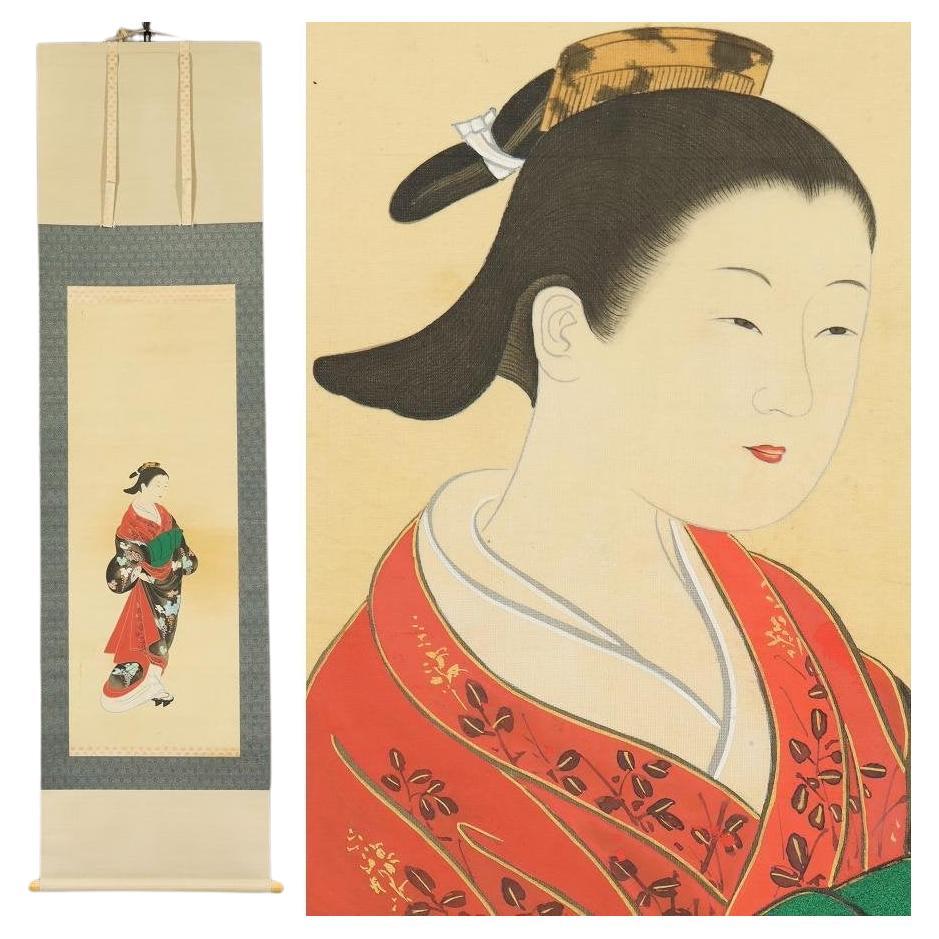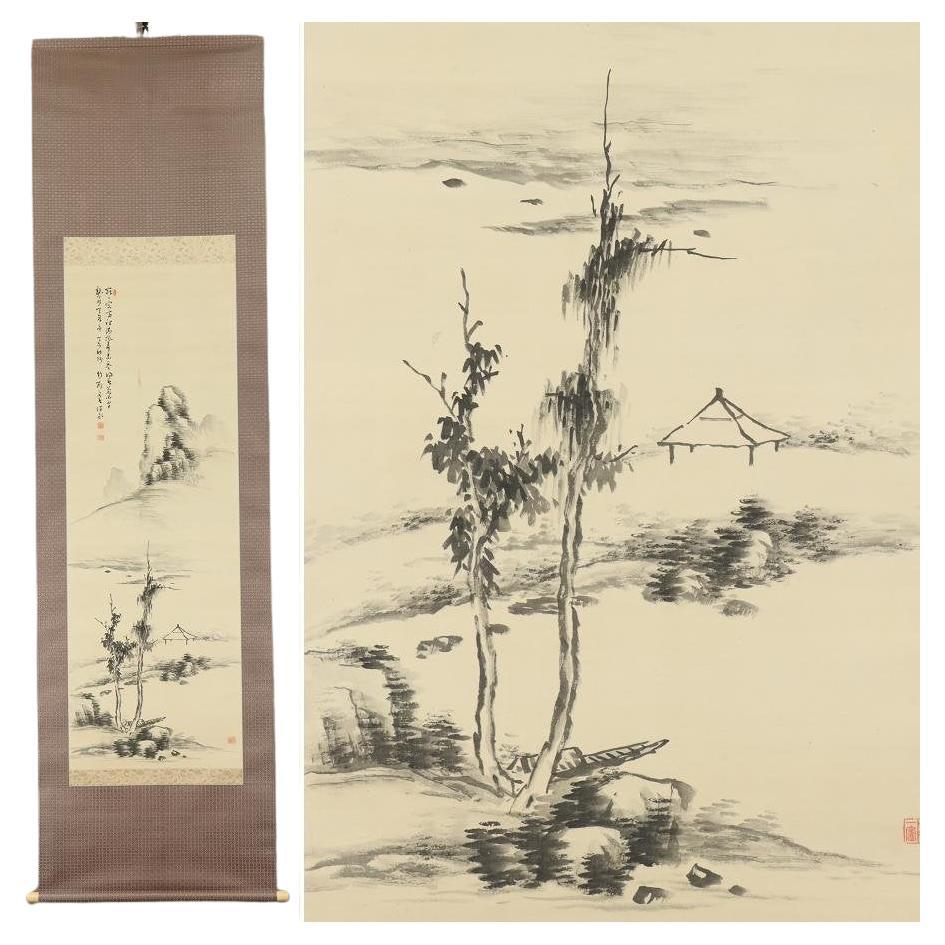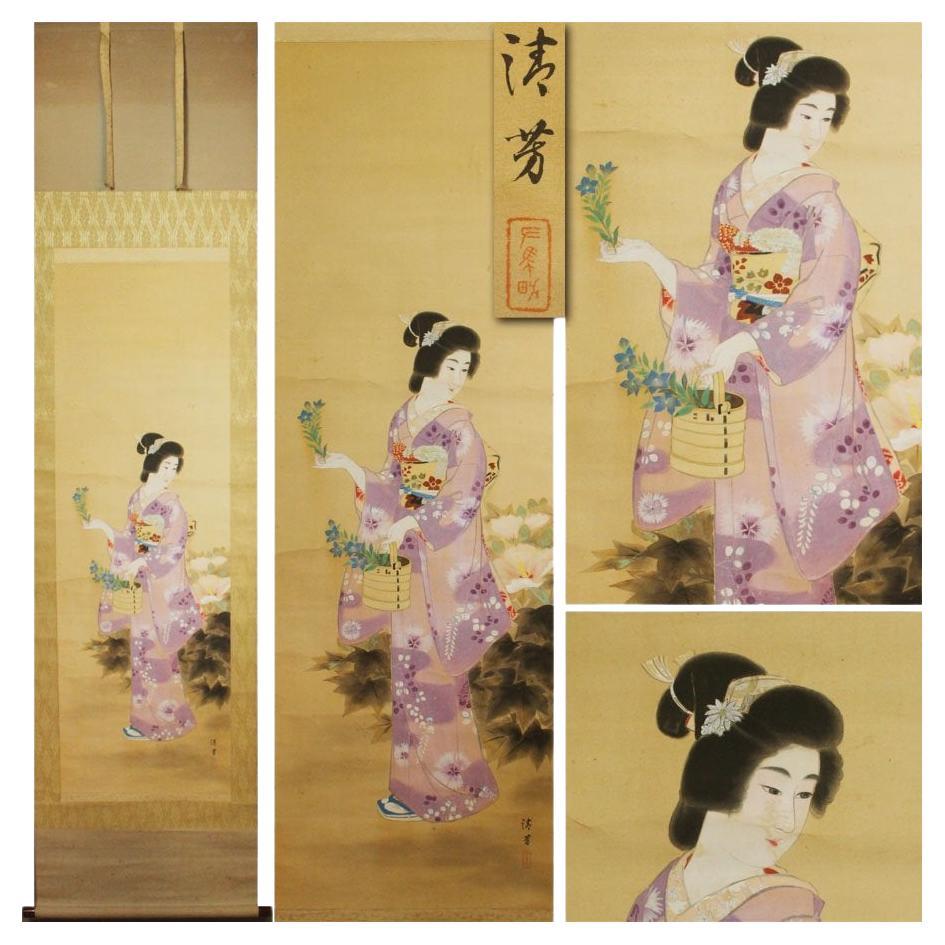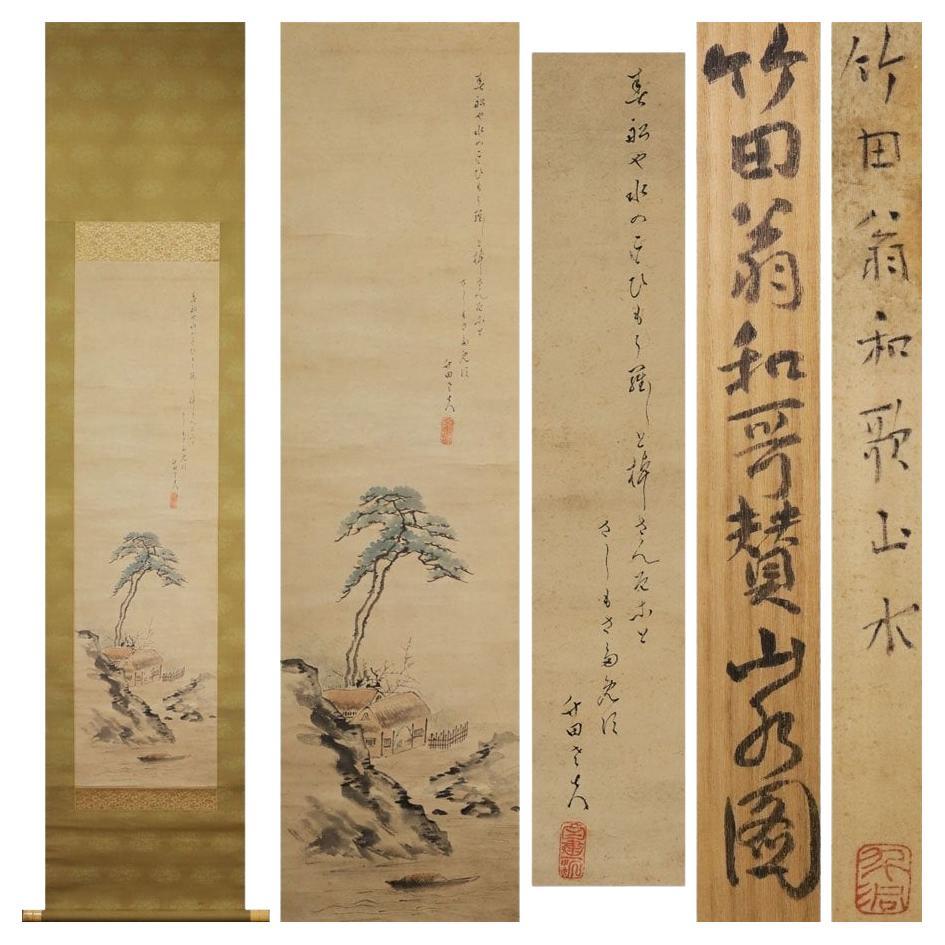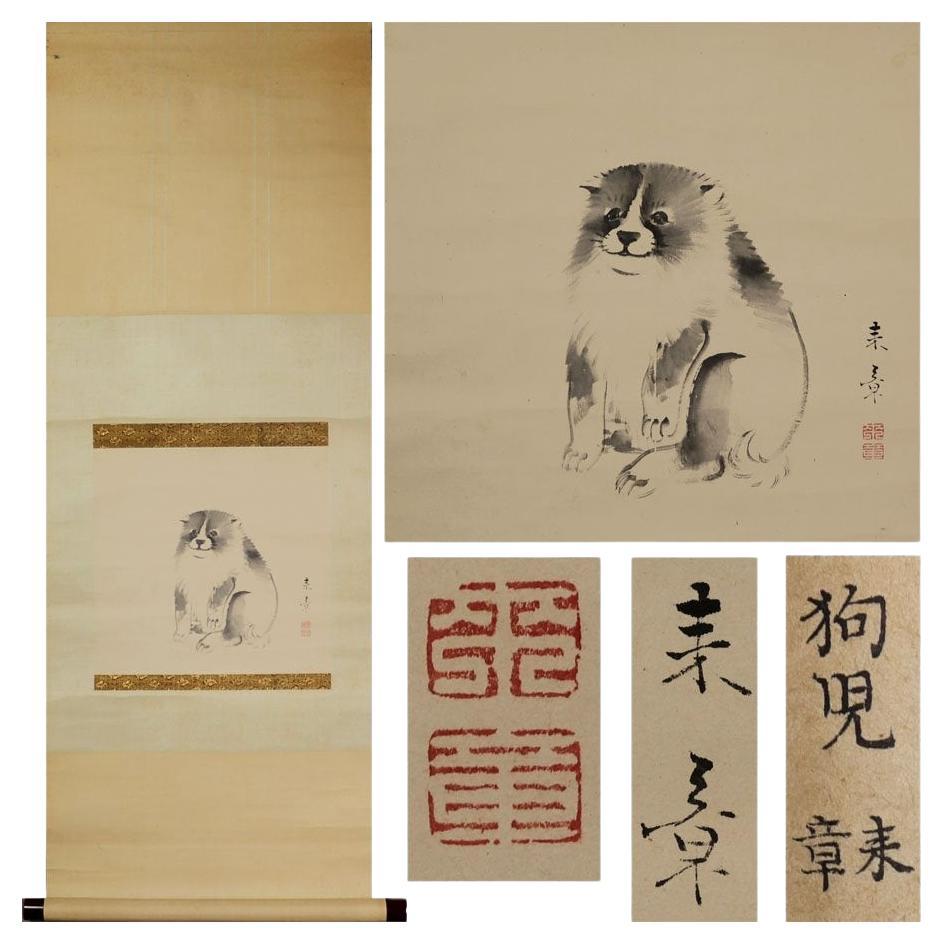Items Similar to Japanese Nihonga Painting 19th Meiji Scroll Ukiyo-E Lady picking Clams
Want more images or videos?
Request additional images or videos from the seller
1 of 8
Japanese Nihonga Painting 19th Meiji Scroll Ukiyo-E Lady picking Clams
About the Item
Product Description This piece depicts a beautiful woman with her skirts
rolled up as she hunts for clams on a shallow shore , giving it an indescribably impressive expression.
■Silk book, handwritten
■Condition
: There are some stains.
■Dimensions
Axis dimensions: approx. 192.0cm x approx. 53.0cm.
Main paper dimensions: approx. 110.5cm x approx. 41.5cm.
■Inscriptions
There are inscriptions and inscriptions, etc. as shown.
■Box
- Dimensions:Height: 75.6 in (192 cm)Width: 20.87 in (53 cm)Depth: 0.04 in (1 mm)
- Style:Edo (Of the Period)
- Materials and Techniques:
- Period:
- Date of Manufacture:ca 1870
- Condition:Wear consistent with age and use.
- Seller Location:Amsterdam, NL
- Reference Number:
About the Seller
5.0
Gold Seller
These expertly vetted sellers are highly rated and consistently exceed customer expectations.
Established in 2015
1stDibs seller since 2019
158 sales on 1stDibs
Typical response time: 9 hours
- ShippingRetrieving quote...Ships From: Amsterdam, Netherlands
- Return PolicyA return for this item may be initiated within 14 days of delivery.
More From This SellerView All
- Japanese Nihonga Painting 19th Meiji Scroll Ukiyo-E Beautifull LadyLocated in Amsterdam, Noord Holland◆ Ukiyo-e ◆ Beautiful woman painting ◆ Japanese painting ◆ Hand-painted painting ◆ Silk ◆ Hanging scroll ◆ This work is drawn by hand and on...Category
Antique 19th Century Edo Paintings
MaterialsSilk
- Japanese Nihonga Painting 19th Meiji Scroll Tajika Chikuson Landscape NangaLocated in Amsterdam, Noord Holland[Authentic Artwork] ◆ Chikuson Tajika ◆ Autumn Landscape ◆ Master: Naoiri Tanomura ◆ Oita Prefecture ◆ Hand-Painted ◆ Silk Mounted ◆ Hanging Scroll ◆ Delve into the artistry of Chik...Category
Antique 19th Century Edo Paintings
MaterialsSilk
- Japanese Nihonga Painting 20th Showa/Taisho Scroll Ukiyo-E Beautifull LadyLocated in Amsterdam, Noord Holland[Kiyoshi Shimizu] Born in Tokyo in 1909, Kiyoshi Shimizu was a Japanese painter active during the early Showa period. Residing in Adachi Ward, Tokyo, he apprenticed under Yokoo Yosh...Category
20th Century Taisho Paintings
MaterialsSilk
- Lovely Japanese 19th c Edo Scroll Okumura Sekiran Nihonga Painting MountainLocated in Amsterdam, Noord Holland"Early Summer Colored Waterfall" is a work drawn by Sekiran Okumura as you can see. The brilliance of the fresh greenery and the cool, powerful presence of the waterfall are overw...Category
Antique 18th Century Edo Paintings
MaterialsSilk
- Japanese Nihonga Painting 18/19th c Edo Scroll Tanomura Chikuden Self PortraitLocated in Amsterdam, Noord HollandTanomura Takeda's handwritten self-portrait hymn "Painted Landscape" with himself working in a hut Takeda Tanomura and depicts fields and mountains in spring, and is accompanied by a self-written waka poem that is thought to be about the scene. [Tanomura Takeda] A painter from Takeda Village, Naoniri District, Bungo Province (present-day Takeda City). His family was born as the second son of Ken'an, who had been a samurai physician in the Oka domain for generations. He first studied medicine, but preferred learning over medicine, and studied Chinese studies under Kimizan Karahashi, a He also learned painting techniques from Buncho Tani, and after returning to Japan, he served as the president of a domain school. He resigned his post in 1812 and traveled between Keihan and Osaka, where he interacted with Raizanyo, Shinozaki Kotake, Urakami Gyokudo, Okada Yonezanjin, Unka Shonin, Aoki Mokubei...Category
Antique 18th Century Edo Paintings
MaterialsSilk
- Japanese Nihonga Painting 19th c Edo Scroll by Nakajima Raiaki River landscapeLocated in Amsterdam, Noord Holland[Raisho Nakajima] lived from 1796 to 1871, at the end of the Edo period and early Meiji period. A person from Otsu, Omi Province (Shiga Prefecture). His name is Ziqing. His names i...Category
Antique 19th Century Edo Paintings
MaterialsSilk
You May Also Like
- Japanese Painting, Hanging Scroll, 19th Century Bamboo in MoonlightLocated in Kyoto, JPBamboo in moonlight Gamo Rakan (1784-1866) Hanging scroll, ink on silk. Dimensions: Scroll: 201 cm x 58 cm Image: 137 cm x 45 cm In this early 19th century work by Gamo Rakan a light ink wash applied to the silk background silhouettes the moon and suggests the atmosphere of early evening. Even though it is a literati subject, Rakan’s bamboo is quite realistic with a strong decorative style. The painting finds its inspiration from Chinese Ming dynasty painters who often used a single-tone, jet black stroke to emphasize the calligraphic nature of bamboo. In a different era, decorative would have been seen as somewhat unrefined. But increasingly in the Edo period, it was the hallmark of high style. The Japanese people, in particular the rising merchant class, had gradually become apathetic toward the traditional Sesshu and Kano schools of painting. Chinese professional and amateur painters living in the port of Nagasaki during the 18th century had a profound effect on Japanese painting and the freshness of their style and its decorative appeal contributed greatly to its popularity. Gamo Rakan’s teacher, Tani Buncho...Category
Antique Early 19th Century Japanese Edo Paintings and Screens
MaterialsSilk
- Japanese Meiji Riverside Scroll Painting, c. 1900Located in Chicago, ILAlthough western painting was initially embraced during Japan’s Meiji period (1868-1912), artists brought on a revival of traditional painting styles as they sought to create a modern Japanese style with roots in the past. This exquisite hanging scroll demonstrates the preference for soft layering of gray tones with judicious use of color. The landscape is rendered in soft ink washes that subtly distinguish between water, mountain, and sky. The scroll painting...Category
Early 20th Century Japanese Meiji Paintings and Screens
MaterialsPaper
- 19th Century Japanese Scroll Painting by Igarashi Chikusa, Poppies & ButterfliesLocated in Kyoto, JPPoppies & Butterflies Ink, pigment and gofun on silk Igarashi Chikusa (1774-1844) Signature: Chikusa Ran Zen Upper Seal: Ran Shuzen Lower Seal: Kyoho Dimensions: Scroll: H. 68” x W. 18” (172cm x 45cm) Image: H. 38.5’’ x W. 12.5’’ (98cm x 32cm) This composition shows elegant images of poppies and the butterflies that are inevitably drawn to them. It captures a momentary glimpse into a world both visually dazzling and startlingly realistic. The painting is infused with sensitivity and attention to seasonal change and weather conditions. The thin and fragile poppies are beautifully depicted with brilliant colors and the butterflies are similarly infused with life. The painting is on silk which requires extremely precise painting skills as no element once painted can be removed. Poppies were a favorite subject of Rinpa school artists through the ages. Originally they were somewhat abstracted but by the age of Sakai Hoitsu...Category
Antique Early 19th Century Japanese Edo Paintings and Screens
MaterialsSilk
- 19th Century Japanese Scroll Painting, Birds & Flowers of the Four SeasonsLocated in Kyoto, JPBirds and flowers of the four seasons Early to mid-19th century Ink, pigment and gofun on silk Unidentified artist Signature: S...Category
Antique 1830s Japanese Edo Paintings and Screens
MaterialsSilk
- Japanese Painting, Hanging Scroll, Mid 19th Century, Koi and Water PlantsBy Iwase HirotakaLocated in Kyoto, JPIwase Hirotaka (1808-1877) Koi and Water Plants Hanging scroll, ink, color, gold wash and gold flecks on silk Inscription: Hirotaka Seal: Ille...Category
Antique 1860s Japanese Edo Paintings and Screens
MaterialsSilk
- Antique hanging scroll of Japanese cat/Late Edo-Meiji period/Cat paintingLocated in Sammu-shi, ChibaThis is a picture of a cat drawn by a person named "Toshizumi Nitta" from the end of the Edo period to the beginning of the Meiji period. She is a very simple and cute cat. He is a vassal of the Tokugawa Shogunate, born in Ota City, Gunma Prefecture (southern part of Gunma Prefecture). He was related to the Tokugawa family and lived in a large mansion in the Ota clan in Gunma prefecture. However, the Nitta family's territory was very small, and they were by no means a wealthy vassal. He seems to have lived quite poorly. So he painted cats and sold them to people. The Nitta family continued to draw pictures of this cat for four generations. "Nitta toshizumi" is equivalent to the fourth generation. During the Edo period, sericulture was thriving in the Kanto region. Cats were said to be the gods of silkworms, as they drive away mice, the natural enemies of silkworms. It was the Nitta family who drew such a cat on paper, pasted it in the silkworm chamber, and sold it as a mouse repellent. There were also other monks who painted pictures of cats, but the Nitta family in particular was related to the Tokugawa family, so people believed that paintings of cats had special powers. , a lot of paintings...Category
Antique Late 19th Century Japanese Edo Paintings
MaterialsPaper
